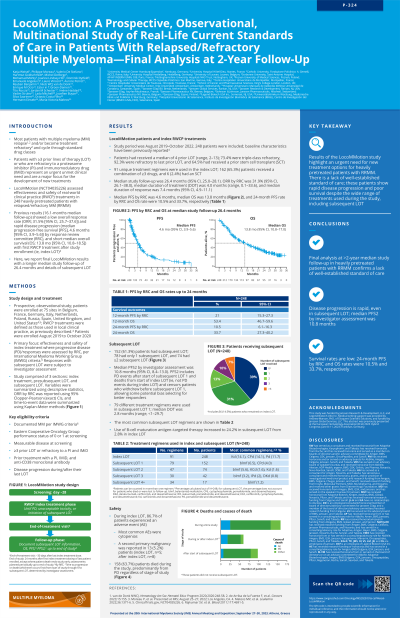Treatment of Relapsed/Refractory Myeloma
Poster Session 2
P-324: LocoMMotion: A prospective, observational, multinational study of real-life current standards of care in patients with relapsed/refractory multiple myeloma–final analysis at 2-year follow-up
Thursday, September 28, 2023
12:30 PM - 1:30 PM EEST


Katja Weisel, MD (she/her/hers)
Deputy Director
University Medical Center of Hamburg-Eppendorf, Hamburg, Germany
Hamburg, Germany
Introduction: LocoMMotion (NCT04035226) is a prospective observational study assessing effectiveness and safety of real-world standard of care (SOC) treatments (tx) for triple-class exposed (TCE) patients (pts) with relapsed/refractory multiple myeloma (RRMM). Here we report final results from LocoMMotion.
Methods: Pts were TCE, double refractory to a PI and IMiD or with ≥3 prior lines of therapy (LOT), had documented progressive disease (PD) since last LOT and ECOG PS ≤1. Pt-level data for first tx upon study enrollment (index LOT) and subsequent LOT were collected for 24 months (mo) after first dose of last pt enrolled. Primary endpoint was overall response rate (ORR) by response review committee (RRC) assessment per IMWG response criteria. Secondary endpoints included median progression-free survival (mPFS) by RRC, median overall survival (mOS), and adverse events (AEs). Statistical analyses used descriptive statistics and Kaplan-Meier methods.
Results: Study period was Aug 2019-Oct 2022 with median follow-up 26.4 mo (95%CI 25.0–28.1). N=248, median age 68 y (range 41–89). At baseline, pts had received median 4 prior LOT (range 2–13), 182 (73.4%) were triple-class refractory, 229 (92.3%) were refractory to last prior LOT, and 160 (64.5%) had prior stem cell transplantation (SCT). 91 unique tx regimens were used in index LOT, 162 pts (65.3%) had ≥3 drugs, 6 (2.4%) had SCT. Median duration of treatment (mDOT) was 4.0 mo (range 0.1–33.6). ORR was 31.9% (95%CI 26.1–38.0); median duration of response was 7.4 mo (95%CI 4.9–11.1), mPFS was 4.6 mo (95%CI 3.9–5.6), mOS was 13.8 mo (95%CI 10.8–17.0). 12- and 24-mo PFS rates were 21.0% (95%CI 15.3–27.3) and 10.5% (95%CI 6.1–16.3), and 12- and 24-mo OS rates were 53.4% (95%CI 46.7–59.6) and 33.7% (95%CI 27.3–40.2).
36 pts (14.5%) did not receive subsequent LOT and remained on index LOT, 78 (31.5%) had only 1 subsequent LOT and 74 (29.8%) had ≥2. mPFS2 (from start of study through subsequent LOT1), by investigator assessment, was 10.8 mo (95%CI 8.4–13.0). 79 different regimens were used in subsequent LOT1 with mDOT 2.8 mo (range < 1–29.7). BCMA-targeted tx use increased from 2.8% in index LOT to 24.2% in subsequent LOT. 86.7% of pts experienced AEs during index LOT, most commonly cytopenias. 13 pts (5.2%) reported a second primary malignancy (index LOT, n=5; after index LOT, n=8). 158 pts (63.7%) died during the study most commonly due to PD (67.7%) and AEs (15.8%). 60 pts (24.2%) died during/after index LOT without starting subsequent LOT; 58.3% due to PD, 30.0% due to AEs. 98 pts (39.5%) died after starting subsequent LOT; 73.5% due to PD, 7.1% due to AEs.
Conclusions: Final analysis of LocoMMotion shows a lack of well-established real-world SOC txs, rapid disease progression, and poor survival despite the wide range of txs used during the study, including subsequent LOT. These findings highlight a need for new therapeutic options in this population.
Data previously presented at the European Hematology Association (EHA) 2023 Hybrid Congress.
Methods: Pts were TCE, double refractory to a PI and IMiD or with ≥3 prior lines of therapy (LOT), had documented progressive disease (PD) since last LOT and ECOG PS ≤1. Pt-level data for first tx upon study enrollment (index LOT) and subsequent LOT were collected for 24 months (mo) after first dose of last pt enrolled. Primary endpoint was overall response rate (ORR) by response review committee (RRC) assessment per IMWG response criteria. Secondary endpoints included median progression-free survival (mPFS) by RRC, median overall survival (mOS), and adverse events (AEs). Statistical analyses used descriptive statistics and Kaplan-Meier methods.
Results: Study period was Aug 2019-Oct 2022 with median follow-up 26.4 mo (95%CI 25.0–28.1). N=248, median age 68 y (range 41–89). At baseline, pts had received median 4 prior LOT (range 2–13), 182 (73.4%) were triple-class refractory, 229 (92.3%) were refractory to last prior LOT, and 160 (64.5%) had prior stem cell transplantation (SCT). 91 unique tx regimens were used in index LOT, 162 pts (65.3%) had ≥3 drugs, 6 (2.4%) had SCT. Median duration of treatment (mDOT) was 4.0 mo (range 0.1–33.6). ORR was 31.9% (95%CI 26.1–38.0); median duration of response was 7.4 mo (95%CI 4.9–11.1), mPFS was 4.6 mo (95%CI 3.9–5.6), mOS was 13.8 mo (95%CI 10.8–17.0). 12- and 24-mo PFS rates were 21.0% (95%CI 15.3–27.3) and 10.5% (95%CI 6.1–16.3), and 12- and 24-mo OS rates were 53.4% (95%CI 46.7–59.6) and 33.7% (95%CI 27.3–40.2).
36 pts (14.5%) did not receive subsequent LOT and remained on index LOT, 78 (31.5%) had only 1 subsequent LOT and 74 (29.8%) had ≥2. mPFS2 (from start of study through subsequent LOT1), by investigator assessment, was 10.8 mo (95%CI 8.4–13.0). 79 different regimens were used in subsequent LOT1 with mDOT 2.8 mo (range < 1–29.7). BCMA-targeted tx use increased from 2.8% in index LOT to 24.2% in subsequent LOT. 86.7% of pts experienced AEs during index LOT, most commonly cytopenias. 13 pts (5.2%) reported a second primary malignancy (index LOT, n=5; after index LOT, n=8). 158 pts (63.7%) died during the study most commonly due to PD (67.7%) and AEs (15.8%). 60 pts (24.2%) died during/after index LOT without starting subsequent LOT; 58.3% due to PD, 30.0% due to AEs. 98 pts (39.5%) died after starting subsequent LOT; 73.5% due to PD, 7.1% due to AEs.
Conclusions: Final analysis of LocoMMotion shows a lack of well-established real-world SOC txs, rapid disease progression, and poor survival despite the wide range of txs used during the study, including subsequent LOT. These findings highlight a need for new therapeutic options in this population.
Data previously presented at the European Hematology Association (EHA) 2023 Hybrid Congress.
